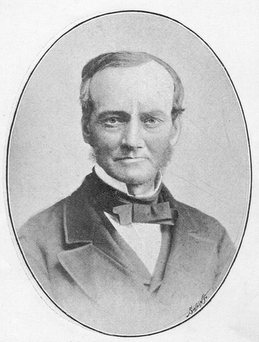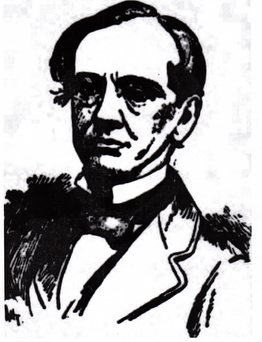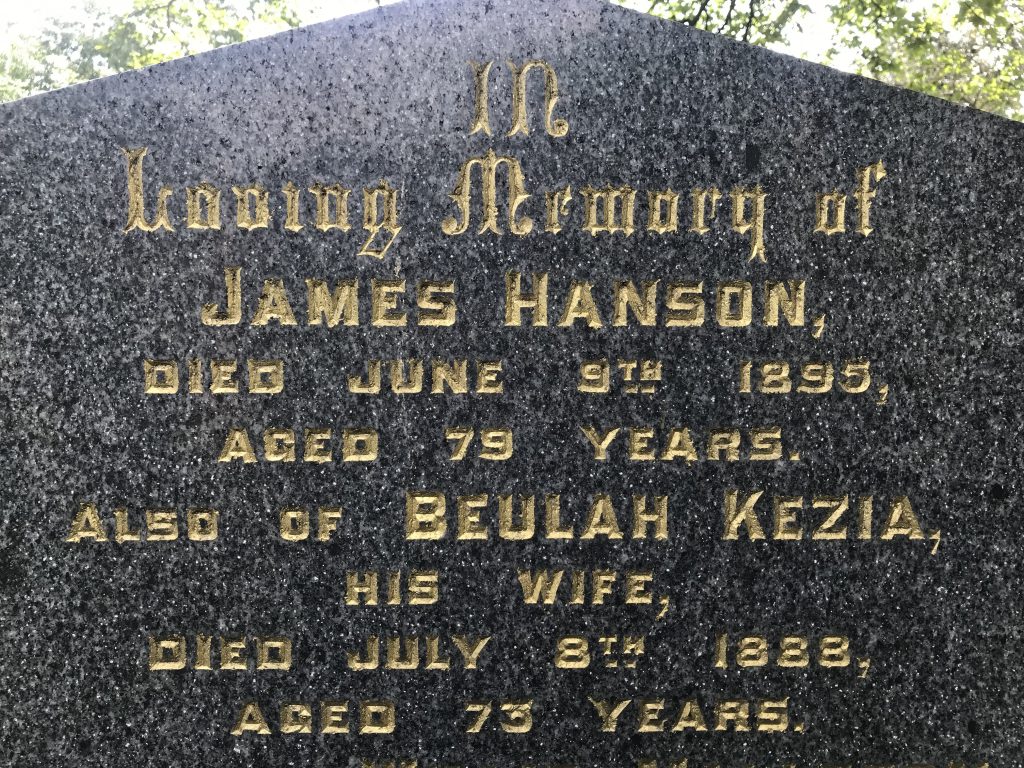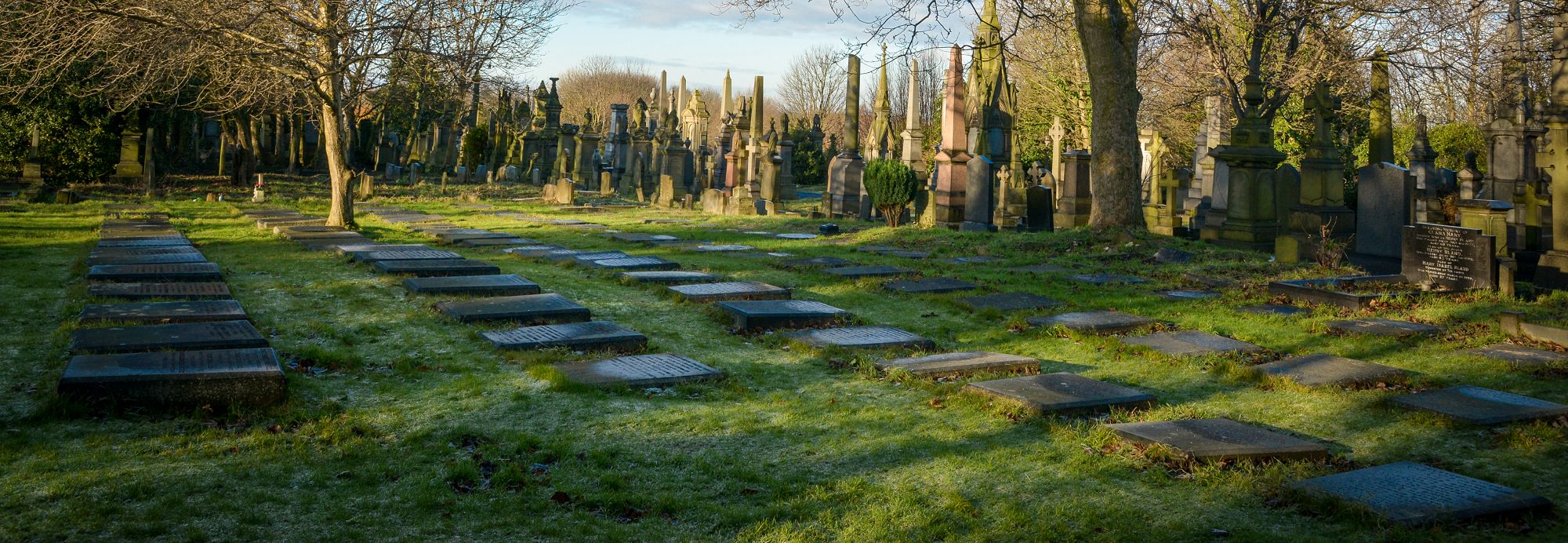James Hanson
James Hanson (1815-1895), Pioneer Educationist.
John C Jackson.
In late Victorian Bradford one person above any other individual was instantly recognisable to the town’s inhabitants, and his countenance was especially familiar to local school children, and to those people who were in any way connected with education.

That person was James Hanson who, for almost 24 years, was a member of the Bradford School Board. In that capacity he visited with diligent regularity the educational establishments for which he was responsible. He espoused education in all its forms, and he devoted almost his entire life to the promotion of learning, especially for the working classes. Hanson inaugurated in Bradford the first local authority secondary school in the country, and it is fitting that his memorial in the city is the school which bears his name and can trace its origins to this pioneering establishment.1
James Hanson was born on 1 October 1815, at Paddock, then a suburb of Huddersfield and a little over a mile to the west of the town centre. His parents were Benjamin and Hannah Hanson, and his father was the proprietor of a small woollen manufacturing business with premises in Huddersfield and in the Dean Head valley.
His own early education was of a rudimentary character. He first attended a ‘dames’ school in Dean Head village, and later he was taught little more than the ‘Three Rs’ by a local Baptist minister. This simple instruction was abruptly ended at the age of eight when he was set to work full time in his father’s mills.
However, Hanson’s formative years were interspersed with periods of work in the family business and in the pursuit of education, and a mixture of both at the same time. It was said of him that “he had a profound thirst for knowledge.” An early indication of his interest in teaching is evident from the age of 14 when he gave instruction in reading to his father’s employees during their break periods. Attendance at night school paved the way for Hanson to fulfil his desire to become a teacher. In 1834, soon after his father’s death, he became a school ‘usher’, effectively second master in a day and boarding school in the Huddersfield area. He occupied the same position in a number of local academies during the following five years.
Hanson’s association with the rapidly expanding town of Bradford began in 1840 when he purchased a private school located in (or about) Manor Row. The school, described as being “in a low condition” with only ten pupils improved considerably during his tenure which lasted until 1850 when the roll had increased to 50.
Hanson was particularly interested in the study of mathematics and languages, and he was also “an ardent student of philosophy, political economy, [and] history.” He instructed the higher classes at the Bradford Mechanics’ Institute in English literature, logic, and mental philosophy. He was secretary of that body between 1848 and 1850.
In 1850, Hanson returned to Huddersfield to join his brother as a woollen manufacturer, but after about four years he abandoned altogether that profession to become a tutor of English and Classics on the staff of Huddersfield College. However, he remained only twelve months when a dispute with the governing body prompted the resignation of the principal and several members of the teaching staff. He then started a private school in Huddersfield, but gave that up in 1858. Hanson also taught at the town’s Mechanics’ Institute and at the Female Education Institute where he remained until 1857 when he returned to Bradford which, by then, was well established as the most rapidly expanding town in the kingdom.
James Hanson’s next venture was to set up The Bradford Review, a journal that sought to appeal to the radical section of the Liberal Party. This he edited and published weekly between January 1858 and February 1870. In November 1867, Hanson instigated and promoted in his periodical the idea that a free public library should be inaugurated in Bradford, an action which came to fruition in 1872 when the Borough Council opened the first municipal library. (Hanson himself amassed during his lifetime a personal library comprising 12,000 volumes).
The Bradford Review, although widely read, was not a financial success, and thereafter Hanson concentrated on the family business of printing, and also on his passionate interest in the promotion of education. On 14 September 1870, he placed the following advertisement in the Bradford Observer.
Advanced Classes. – James Hanson proposes forming evening classes for the study of English Language, English Literature, English Constitutional History, Political Economy, History of Philosophy. Prospectuses of these Classes may be had of Mr. Hanson, Godwin Street, or of the Booksellers.
Hanson’s interest in education continued through his vice presidency, and a directorship, for many years, of the Bradford Mechanics’ Institute, where he was also one of its honorary secretaries. He associated himself closely with the Council of the Yorkshire Union of Mechanics’ Institutes. He was a governor of the Bradford Grammar School (then in the process of revitalising itself), and of the Bradford Girls’ Grammar School (opened in 1876 as the first of its kind in the country), and he was a member of the Council of the Technical College.
James Hanson’s opportunity to devote himself wholeheartedly to the cause of education came in 1870. On 9 August, Royal Assent was given to the Elementary Education Act. Its architect was William Edward Forster, Liberal Member of Parliament for Bradford. After the Reform Acts, it was arguably the most important piece of legislation in the nineteenth century. The act provided for the establishment of local school boards to ‘fill up gaps’ where existing voluntary provision fell short, and to make available universal elementary education for the working classes.
At a meeting of the Borough Council held on 20 September 1870, it was unanimously resolved to petition the Lords of the Committee of the Privy Council on Education to sanction the provision of a school board for Bradford. Their Lordships promptly agreed to the request, and 46 men put their names forward for 15 seats. The mayor, anxious to avoid the expense and acrimony of an election, was able by agreement to reduce the number to 16 ‘influential’ candidates. Hanson, whose name was advanced by the working men of the town, was asked to withdraw but he emphatically refused. In the end, another candidate voluntarily withdrew his nomination and the Bradford School Board was formally constituted on 30 November 1870.
Hanson’s took a keen interest in all aspects of the Board’s work, but it was in the area of attendance and, most importantly, school management that he was primarily concerned. It was he who insisted on the opening of schools in temporary rented premises pending the erection of permanent buildings. Accordingly, the first Board schools in Bradford – four in number – were established on 17 February 1873, and in 1874 these were superseded by eight purpose-built schools. Hanson was Chairman of the influential School Management Committee from its inauguration until his retirement. He said of this appointment that it was “quite the most important committee of the Board – a committee of which it has sometimes been said that we did all that was of importance.”

Among the first permanent Board schools was that in Feversham Street where it soon became apparent that the number of available places far exceeded that for which there was demand. The building was underused and as a means of rectifying this problem James Hanson, encouraged by local HMI Walter Baily, proposed that the boys’ and girls’ department be amalgamated, and that the building vacated by the former be used for the setting up of a higher elementary school wherein the education was to be far in advance of the rudimentary ‘Three Rs’ – reading, writing, and arithmetic. No half-timers were to be admitted, and a weekly fee of 9d (the maximum permitted by the act, and three times that in the ordinary schools) was to be charged. A graduate head teacher was appointed, and the Feversham Street Higher Grade Boys’ Board School opened without ceremony on 3 April 1876.
Without realising it, Hanson had inaugurated what was essentially the first local authority secondary school in the country. Such was its success that most of the large school boards, especially those in the north of England, quickly copied Bradford’s pioneering idea. 2
In the late 1880s, James Hanson appeared before a Royal Commission, the purpose of which was ‘To inquire into the working of the Elementary Education Acts, England and Wales’. Hanson gave evidence before the commissioners on the contentious question of non-sectarian Christian teaching in Board Schools, and his testimony appeared in The Cross Report published in 1888.
In 1888, against the wishes of his fellow Liberal nonconformist colleagues, but with the support of the Conservative denominationalists, Hanson was elected Chairman of the Bradford School Board. He occupied that office for two terms and carried out his duties “with an assiduity and a vigour which, considering his age, were truly remarkable.” It was during this period that he represented the School Board at an educational conference in Chicago, and while in the United States he visited a number of advanced educational institutions, “the fruits of his observations [being] subsequently given to the teachers of Board Schools in a lecture which he delivered to them on his return.”
Hanson retired from the Bradford School Board at its triennial election in 1894. He did not stand idly by during the contest but instead promoted the candidature of those with whom he had fostered like-minded ideas. He “seemed to delight in telling the ratepayers that he had never cared how much money he had spent, provided it had been well used in advancing the education of the people.”
A public subscription in recognition of his lifelong services to the cause of education was inaugurated in the town. Over £800 was raised but only a portion of that sum was given to him before his death which occurred on 9 June 1895 at his home, 30 Southfield Square, Bradford. He was 79 years old.
A long funeral procession accompanied James Hanson’s body through the streets of Bradford to Undercliffe Cemetery where six school attendance officers bore his coffin to the grave. The Reverend T. Rhondda Williams, minister of Greenfield Congregational Church, Manningham, stated that Hanson had been “an active public servant of eminent ability and unflinching devotion”, observing also that “content with a small house and a moderate fee he could be, but content with an ill-informed mind and shallow interests he could not be.”

A further tribute to his memory was paid many years later by William Claridge, Chairman of the Bradford School Board at the final meeting of that pioneering institution on 21 December 1903: “Of the men who have taken a prominent part in the important work of changing the character of Bradford from one of dense ignorance to that of being one of the pioneer educational forces in the country, I place, first and foremost, my old friend James Hanson.”
On 1 July 1841, James Hanson married Beulah Kezia Eagleton. She was the daughter of John Eagleton, an Independent Minister of considerable note who was pastor of Ramsden Street Chapel, Huddersfield from 1826 until his untimely death in 1832. The nuptials took place at Highfield Independent Chapel, Huddersfield, and were conducted by the Reverend John Glendenning. Witnesses to the ceremony were Jehoiada Joseph Eagleton and Elizabeth Eagleton. The marriage register entry states James’s occupation to be that of ‘Tutor’, and indicates that he was residing at ‘Manor Place, Bradford, Yorkshire’.
Beulah Hanson (1815-1888) was the author of a nationally acclaimed work of fiction called Fanny Lee’s Testimony: A Yorkshire Tale. First published in 1863, and reprinted many times, it won second prize in a national book competition about the evils of drink. (Beulah and James Hanson were advocates of temperance). She had earlier (in 1848) published a book entitled Poetical Trifles: Or Thoughts in Verse. Mrs Hanson’s local newspaper obituary stated, “In all the relations of life sweetness and gentleness were her prevailing characteristics…”
In her biographical work, O Dreams, O Destinations, published in 1962, the Halifax novelist Phyllis Bentley, refers to her great uncle and his family.
James Hanson died the year before I was born, but my mother’s recollections of him made him my hero, and I drew the character of Joth in ‘Inheritance’ from him. James had a lofty idealistic character, a firm religious faith, a passionate belief in education and the Liberal party under Mr Gladstone, a lasting sympathy for the poor, and enough disciplined energy to put his every ideal into vehement and sustained practice.
The Hansons produced eight children, “all of whom”, according to Dr Bentley, “were able and energetic, fluent, disinterested and liberal. They could all teach, they could all speak, they could all write; they loved learning and hated iniquity, they did not suffer fools gladly…”
Fanny Hanson, their daughter, spent her entire career on the staff of the Salt Girls’ High School, Shipley, and was the author of a published novel.
Charles, one of their sons, became a Scottish newspaper editor, and then a leader writer on The Times, and his son, Sir Philip Herbert Hanson, CB, who attended Edinburgh University, and Balliol College, Oxford, where he took a First in Greats, became a prominent official in the Irish Civil Service.
It was said of James Hanson that he was “brusque in manner, and occasionally hasty in temper”, but that “his disposition was nevertheless a kindly one.” Unconventional in outlook, and passionate in the advancement of his own views, he was, according to his obituary in the Bradford Observer, “uniformly straightforward and fairminded in controversy.”
In 1971, I interviewed and recorded a conversation with Miss Rachel Agnes Urquhart, aged 105, who had been appointed to the staff of Feversham Street Infants’ Board School in February 1890. Asked if she remembered James Hanson, Miss Urquhart replied, “James Hanson! Rather! Jimmy. He was a constant visitor of the schools .. Excuse me saying Jimmy .. without being rude .. it was familiar certainly, but .. you knew him. He always had the same walk, bowed head, got on with the job. Quite polite, and quite gentlemanly to meet in the classroom.”
The school log book bears testimony to the frequency of his visits, such as in an entry by Miss Sarah Jane Scafe, headmistress, dated 3 December 1888. “Mr Hanson came in this week & saw the very large classes the Trs had, he said for this school I ought to be over staffed, rather than under. Each Assistant has an average of 60 Chn & the P[upil] Trs an average of 50 Chn.”
The Hanson family grave is located close to the eastern end of the promenade in the unconsecrated portion at section D, plot 66. I refurbished the memorial in 2016.
To find the grave using the what3words App follow this link and select satellite view.
1 Feversham Street Boys’ Higher Grade Board School was established in 1876. It moved to Chapel Street in 1891, and thence to the newly-built Hanson Higher Grade and Organised Science Board School, Byron Street, in 1897 where it shared premises with the former Peckover Girls’ Higher Grade Board School. In 1967, Hanson Girls’ School moved to new premises in Bolton, Bradford, and were joined by Hanson Boys’ School in 1972 to become a co-educational comprehensive school. These premises were rebuilt on the same site in 2011, and can clearly be seen from the promenade in Undercliffe Cemetery.
2 Ironically, it was the success of the higher grade schools that lit the fuse which brought about the abolition of the school boards (and the higher grade schools) under the Education Act 1902. The infamous Cockerton Judgement of 1900 declared expenditure from the municipal rates on higher grade schools to be illegal since the advanced education they provided went far beyond that sanctioned by the Elementary Education Acts.
Further reading:
Bentley, Phyllis E. Letter to A. J. Evans dated 16 November 1945, about “my great-uncle, Mr. James Hanson”. Reproduced in Evans’s thesis (see below). pp. 188-9.
Bradford Daily Telegraph, 10 June 1895. Obituary. “Death of Mr. James Hanson”.
Bradford Observer, 10 June 1895. Obituary. “Death of Mr. James Hanson”.
Bradford Daily Telegraph, c. January 1892, in the series Bradford Portraits. “The Chairman of the School Board”.
Bradford School Board minutes, documents, log books of Board Schools. With the exception of a few of the latter, these are in the custody of the West Yorkshire Archives, Bradford.
Cartwright, Derek. “James Hanson – Bradford’s True Educational Giant”. (Bradford: unpublished family history notes, 2019). Mr. Cartwright’s tenuous link with Hanson is through his fourth cousin Phyllis Bentley, Hanson’s niece.
Evans, Albert J. A History of Education in Bradford During the Period of the Bradford School Board. (MA thesis, University of Leeds, 1947). esp. Chapter 8: “The Chairmanship of James Hanson”.
Hanson Girls’ School, 1897-1967. (Bradford: Privately published, 1967).
Hustwick, Wade. “His name lives on in city schools”. Article published in the Telegraph and Argus on 19 March 1960, in the series Bradford Characters.
Jackson, John C. “Bradford’s First Higher Grade Board School”. In Forster Bulletin. (Bradford: Privately published, May 1972). pp. 45-7.
Metcalfe, Cyril. (ed.) Hanson Boys’ School 1897-1972. (Bradford: Privately published, 1972).
Priestley, Mike. “Truth about that famous mill owner”. Article based on a letter from John C. Jackson correcting anomalies in an earlier article (“Former school is a class apart-ment”, T&A, 13.10.2004) about the former Hanson School building. In Bradford Telegraph and Argus, published on 25 October 2004.
Nicholson, Joseph S. “James Hanson 1815-1895”. In History of Education in Bradford 1870-1970. Bulletin no. 3 (Bradford: Privately published, December 1968). pp. 15-22.
Robinson, Alfred H. “Hanson – A Remarkable Bradfordian”. In Bradford Telegraph and Argus, published on 17 July 1967.
Robinson, Alfred H. “James Hanson”. In Metcalfe, C. (ed.) Hanson Boys’ School, 1876-1972. pp. 5-8.
“School Board Personalities (i) A Liberal: James Hanson”. In Education in Bradford Since 1870. (Bradford: Educational Services Committee Bradford Corporation, 1970). pp. 32-3.

